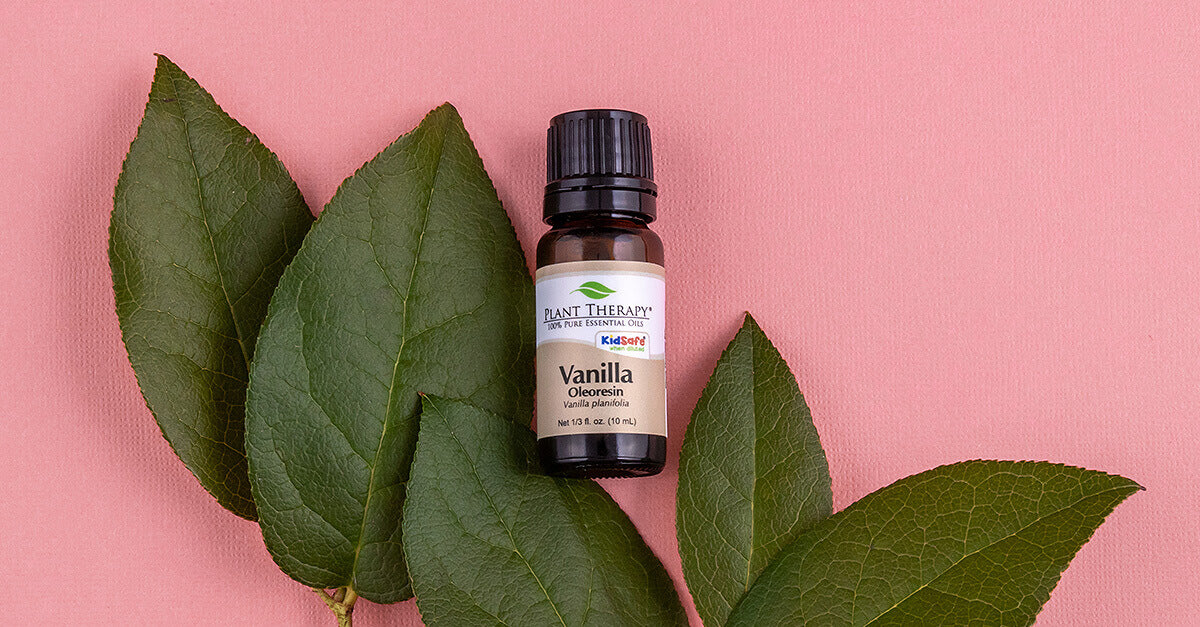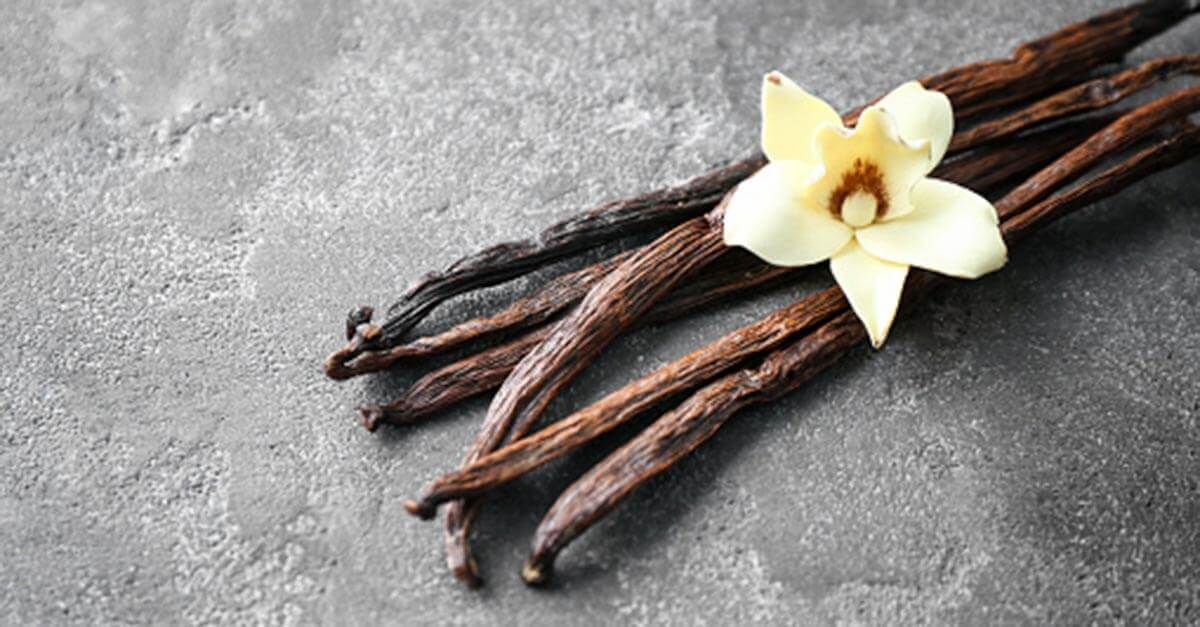Most of us instantly recognize the scent of Vanilla. Reminiscent of baked goods and desserts, Vanilla is a notably sweet aroma. While it possesses an absolutely rich scent, it also holds many benefits and is a great addition to DIY projects and diffuser blends. Let’s find out more about the different variations of Vanilla.
Background of Vanilla
Vanilla “beans” (properly called pods) are the fruit of the Vanilla planifolia orchid, and it’s the most commonly grown variety of Vanilla. The orchid is native to Mexico and other Central American countries but now grows worldwide. In fact, most of today’s commercial crop comes from Indonesia and Madagascar . Growing, harvesting, and processing true beans can be time-consuming as it’s still done mostly by hand.
Initial attempts to grow Vanilla outside of Central America failed completely. Spanish conquistadors who brought the orchids back to Europe failed to recognize that Vanilla fruit won’t grow without being pollinated by a certain type of bee. In the mid-1800s, discovery of hand pollinating was uncovered, allowing it to be grown in various locales .
Since its flowers only last about 24 hours, the orchids go through inspection each day and hand-pollinated one at a time. Once the pollinated flower “sets” fruit (a process that takes 5-6 weeks), the pods will mature on the stem for about six months before harvest action.
 To avoid producing an inferior product, suppliers hand-pick pods at precisely the right time, just when the bean begins yellowing and the terminal end starts to split. The curing process begins after harvesting, which involves stopping the maturation process by various methods such as dunking in boiling water, frozen, “scratched” down their length, heated in a low oven, or dried in the sun. Further curing includes “sweating” the pods, drying them, and then “conditioning” them. The whole process involves at least another six months before the lovely aromatic beans are ready for grading and shipping .
To avoid producing an inferior product, suppliers hand-pick pods at precisely the right time, just when the bean begins yellowing and the terminal end starts to split. The curing process begins after harvesting, which involves stopping the maturation process by various methods such as dunking in boiling water, frozen, “scratched” down their length, heated in a low oven, or dried in the sun. Further curing includes “sweating” the pods, drying them, and then “conditioning” them. The whole process involves at least another six months before the lovely aromatic beans are ready for grading and shipping .
Types of Extracts
First, technically speaking, there is no such thing as Vanilla essential oil. The term “essential oil” refers to products obtained during steam distillation or cold pressing of plant material. Since they are not obtained by either process, the term “essential oil” can’t be applied to Vanilla products. For aromatherapy purposes, Vanilla is obtained either by solvent extraction or by CO2 extraction. There are three vanilla products offered by Plant Therapy: Vanilla Oleoresin, Vanilla 12% C02 Extraction, and Vanilla Botanical.
Vanilla Oleoresin
 Vanilla Oleoresin is a concentrated product made by removing the solvent (usually ethanol) from its extract. This extract holds a thicker consistency, it’s a better addition to DIY projects as opposed to diffusing as it could potentially clog your aromatherapy diffuser.
Vanilla Oleoresin is a concentrated product made by removing the solvent (usually ethanol) from its extract. This extract holds a thicker consistency, it’s a better addition to DIY projects as opposed to diffusing as it could potentially clog your aromatherapy diffuser.
Vanilla Oleoresin only emulsifies (mixes) fully in ethanol (alcohol), it’s a bit more challenging to work with when making product blends. As an example, when you put it into a carrier oil, the oleoresin will sink to the bottom in a “blob” and remain there. But if you put a bit of oleoresin into alcohol, like vodka, it will dissolve completely.
Caramel Latte Salt Scrub
What you’ll need:
- 1/2 cup Fine Grain Pink Himalayan Salt
- 1/4 cup Jojoba Carrier Oil
- Coffee, Sweet Orange, and Vanilla Oleoresin (108 total drops for a 2% dilution–experiment with a few drops of each first to see if you like more of a coffee, vanilla, or orange aroma to stand out.)
What you’ll do:
Add the essential oils and oleoresin to the carrier oil and mix. Then, let stand for a few minutes to meld the aromas together. Next, drizzle the oil mix into the sea salt, stirring until you get the consistency you like. Place into a container with a lid and use within a couple of weeks, as the product has no preservative.
Vanilla 12% CO2
Vanilla 12% CO2 is obtained by the method of supercritical carbon dioxide (chemical formula: CO2) extraction. Under pressure, CO2 gas transforms into an “almost” liquid phase called the supercritical state. Plant material (in this case, vanilla pods/seeds) goes into an airtight receptacle, and carbon dioxide gas is pumped in under pressure; low heat is also applied to aid extraction.
As the pressure inside the container rises, CO2 gas nearly liquifies, bathing the plant material in supercritical CO2. The combination of high pressure and low temperatures encourages the plant material to releases its aromatic components. After a period of time, there is less pressure, and the supercritical CO2 changes back to its gaseous state, completely disappearing from the extracted material.
Vanilla 12% CO2 Extraction emulsifies completely in a carrier oil. Infusing it into Jojoba Oil for a lip balm is a great way to use this. Add 18 drops of Vanilla 12% CO2 per ounce of Jojoba Carrier Oil and mix thoroughly; then you can use the aromatic infused Jojoba Oil as the liquid oil part of your favorite lip balm recipe.
 12% refers to the percentage of the naturally occurring component vanillin, which provides vanilla with its characteristic warm, sweet aroma. There are also CO2 extracts containing 26% and 30% Vanillin; these are often used in perfumery and are a bit more challenging to work with as they are solid or semi-solid at room temperature.
12% refers to the percentage of the naturally occurring component vanillin, which provides vanilla with its characteristic warm, sweet aroma. There are also CO2 extracts containing 26% and 30% Vanillin; these are often used in perfumery and are a bit more challenging to work with as they are solid or semi-solid at room temperature.
Note: Plant Therapy is currently sold out of this product; however, this is valuable information on the CO2 and we will keep this information for the blog.
Vanilla Botanical
Sustainably sourced from Uganda, Vanilla Botanical holds a rich, intense, and sweet aroma. Uganda is one of the main areas of vanilla production in the world, with perfect agri-climatic conditions. The green beans are harvested in June-July and December-January. In Uganda, a fast-curing and hydro-distillation process has been developed resulting in a higher content of vanillin, giving the final product its aroma. It becomes a favorite to add to body care products or DIY beauty projects. Vanilla Botanical also can help release feelings of agitation, thus providing a relaxing, calm environment.
References:
Lubinsky P, Bory S, Hernandez-Hernandez J et al. Origins and Dispersal of Cultivated Vanilla. Economic Botany 62 (2): 127-38, 2008.
Correll D. Vanilla: Its Botany, History, Cultivation, and Economic Importance. Economic Botany 7: (4), 291-358, 1953.
Havkin-Frenkl D, French JC, Pak FE, Frenkl C. Interrelation of Curing and Botany in Vanilla (Vanilla planifolia) Bean. Acta Horticulturae 2004: 93-102.









